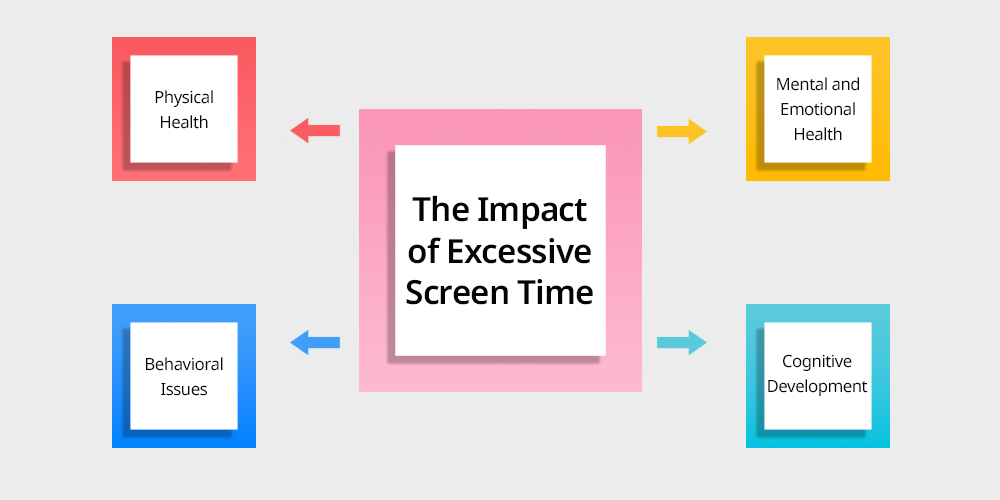In today’s digital world, screens have become an inseparable part of children’s lives. However, too much screentime can be harmful to their development. Studies suggest that excessive exposure to screens—especially in early childhood—can lead to attention problems, speech delays, sleep disturbances, and behavioral issues. One growing concern is virtual autism, a condition where young children show autism-like symptoms due to prolonged screen exposure rather than a neurological disorder. These symptoms often improve when screen time is significantly reduced and real-life interactions are increased. Understanding the potential dangers of too much screen time, including the risk of virtual autism, is crucial for protecting your child’s mental, emotional, and social well-being.
What Do You Mean by Screen Time?
Screentime refers to the total time a child spends using devices with screens—like TVs, smartphones, tablets, computers, and gaming consoles. It includes both passive activities (such as watching cartoons or YouTube) and interactive ones (like playing games or using educational apps). In moderation and with proper supervision, screen time can support learning and communication. However, when it’s excessive or unstructured, it can interfere with your child’s sleep, behavior, and development. That’s why understanding and setting healthy limits based on your child’s age is essential.
General recommendations by the American Academy of Pediatrics (AAP):
- Under 18 months: Avoid screen time completely, except for live video calls.
- 18–24 months: Introduce only high-quality content, and watch it together.
- 2–5 years: Limit to 1 hour per day of educational, age-appropriate content.
- 6 years and above: Set consistent limits so screen use doesn’t replace sleep, physical activity, or family interaction.

How Excessive ScreenTime Affects Brain Development
The early years of a child’s life—especially from birth to age five—are a period of rapid brain development. During this time, the brain forms vital neural connections that support speech, movement, emotional control, social understanding, and cognitive skills. These connections are shaped largely by real-life experiences—such as talking, listening, playing, touching, exploring, and interacting with people. Excessive screen exposure during these sensitive years can have the following effects:
- Delayed speech and language skills
When children spend hours watching videos instead of engaging in two-way conversations, their ability to express themselves and understand others can be delayed. Screens can’t replace the rich, responsive communication that happens during human interaction. - Poor attention span
Constant exposure to fast-moving visuals and instant feedback from digital content can make it hard for the brain to adapt to slower-paced real-life tasks like reading, problem-solving, or classroom learning. - Reduced emotional understanding
Emotional skills are developed by observing facial expressions, hearing tone of voice, and responding to real people. Screens don’t offer this emotional depth, making it harder for children to develop empathy, patience, and self-control. - Lower creativity and imagination
Passive screen viewing doesn’t encourage imagination or problem-solving. Activities like building with blocks, pretend play, or storytelling stimulate the brain far more than watching pre-made videos or animations. - Sensory imbalance Children need to touch, feel, move, and interact with the world to make sense of it. Overreliance on screens can result in sensory processing issues and reduce curiosity about the real world.

Does Excessive Screentime Impact Attention Span?
Yes, significantly. Children’s brains are still developing, and when they are exposed to fast-paced visuals, constant audio-visual stimulation, and instant gratification from digital content, it can rewire how they process information and respond to their environment.
Children who spend long hours on screens often find it difficult to:
- Focus on slow or real-world tasks, such as reading a book, solving puzzles, or listening to a teacher
- Practice patience or sit still during non-stimulating activities like meals, family conversations, or classroom routines
- Follow instructions or complete tasks that require concentration, such as writing, organizing toys, or doing homework
This is because the brain starts expecting the same speed and stimulation in everyday life—which real-world situations rarely provide.

Can Too Much Screen Time Mimic Autism Symptoms?
Some children develop behaviors similar to those seen in autism when exposed to excessive screen time—this is known as “Virtual Autism.” These behaviors can include:
- Lack of eye contact
- Delayed speech or nonverbal communication
- Repetitive movements
- Preference for screens over people
Fortunately, in many such cases, reducing screentime and encouraging social interaction can lead to noticeable improvements in behavior and communication.
Sleep Disruptions Due to Screen Use
Sleep plays a vital role in a child’s physical growth, emotional stability, and brain development. However, the increasing use of screens—especially in the evening hours—is one of the most common causes of sleep disturbances in children today. Screens emit blue light, which interferes with the production of melatonin, a natural hormone that signals the body to prepare for sleep. When melatonin levels drop, it becomes harder for children to feel sleepy at the right time, making it difficult for them to fall asleep and stay asleep throughout the night.
Poor sleep in children, especially when it becomes a pattern, can result in:
- Mood swings and irritability
Lack of sleep affects emotional regulation. Children may become cranky, impatient, or more prone to tantrums the next day. - Daytime drowsiness
Without adequate rest, children feel tired and sluggish during the day, which can affect their ability to play, socialize, or stay alert. - Learning difficulties
Sleep is essential for memory consolidation and brain processing. Sleep-deprived children may struggle with concentration, problem-solving, and academic tasks. - Weakened immunity
Sleep helps the body recover and build resistance to illness. Poor sleep can make children more prone to colds, infections, and low energy levels. - Increased risk of behavioral issues Chronic sleep loss is often linked to hyperactivity, impulsiveness, and in some cases, symptoms resembling ADHD.

Physical Health Concerns from Too Much Screen Time
When children spend hours glued to screens, their physical health suffers too. Common health issues include:
- Obesity due to lack of physical activity
- Poor posture from slouching or bending over screens
- Eye strain, dry eyes, or blurry vision
- Weak hand-eye coordination and delayed motor skills
Encouraging active play is crucial for building strong muscles, bones, and coordination.
What Should Parents Do?
As a parent, you play the most important role in shaping your child’s digital habits. Children naturally follow the patterns and behaviors they see at home—especially those modeled by parents. While technology isn’t harmful in itself, its misuse or overuse can be. The goal should not be to ban screens entirely but to create a healthy, balanced relationship with them.
Start by reflecting on your child’s current screen routine and your own media habits. Ask yourself:
- Is this content educational and age-appropriate?
- Is screen time replacing playtime or family interaction?
- Am I being a good role model with my own screen usage?
If screentime is becoming your child’s main source of entertainment, it’s time to reassess.

Tips for Managing Screen Time Effectively
Here are practical ways to ensure screentime doesn’t negatively impact your child’s growth:
- Set daily screen limits based on age (e.g., under 1 hour for children aged 2–5)
- Avoid screens during meals and 1 hour before sleep
- Choose high-quality, educational content only
- Co-watch whenever possible and talk about what they see
- Introduce offline alternatives—board games, books, painting, or sports
- Designate screen-free zones in the home (like bedrooms)
- Be consistent and patient while changing screen habits
Frequently Asked Questions
Q1: Can screen time cause autism?
No, screentime does not cause autism. But it can lead to symptoms that resemble autism, especially in toddlers—this is often referred to as “virtual autism.”
Q2: What is the right age to introduce screens to children?
Children under 18 months should avoid screens except for video calls. After age 2, you can slowly introduce limited, educational content.
Q3: How do I reduce screen time without tantrums?
Gradually reduce screen time and replace it with engaging, fun activities like storytelling, painting, or outdoor play.
Q4: What if my child is already addicted to screens?
Stay calm and consistent. Set clear rules, reduce exposure slowly, and involve your child in creating a new routine. If needed, consult a child behavior expert.
Conclusion
Technology can educate and entertain—but too much of it can silently harm your child’s mental, emotional, and physical development. Awareness and balance are the key. At Nurturers, we help parents and children manage developmental concerns, offering screening, therapies, and expert guidance.
If you’re worried about your child’s behavior, speech delay, or screen dependency, don’t wait. Get in touch with us for early evaluation and support.

